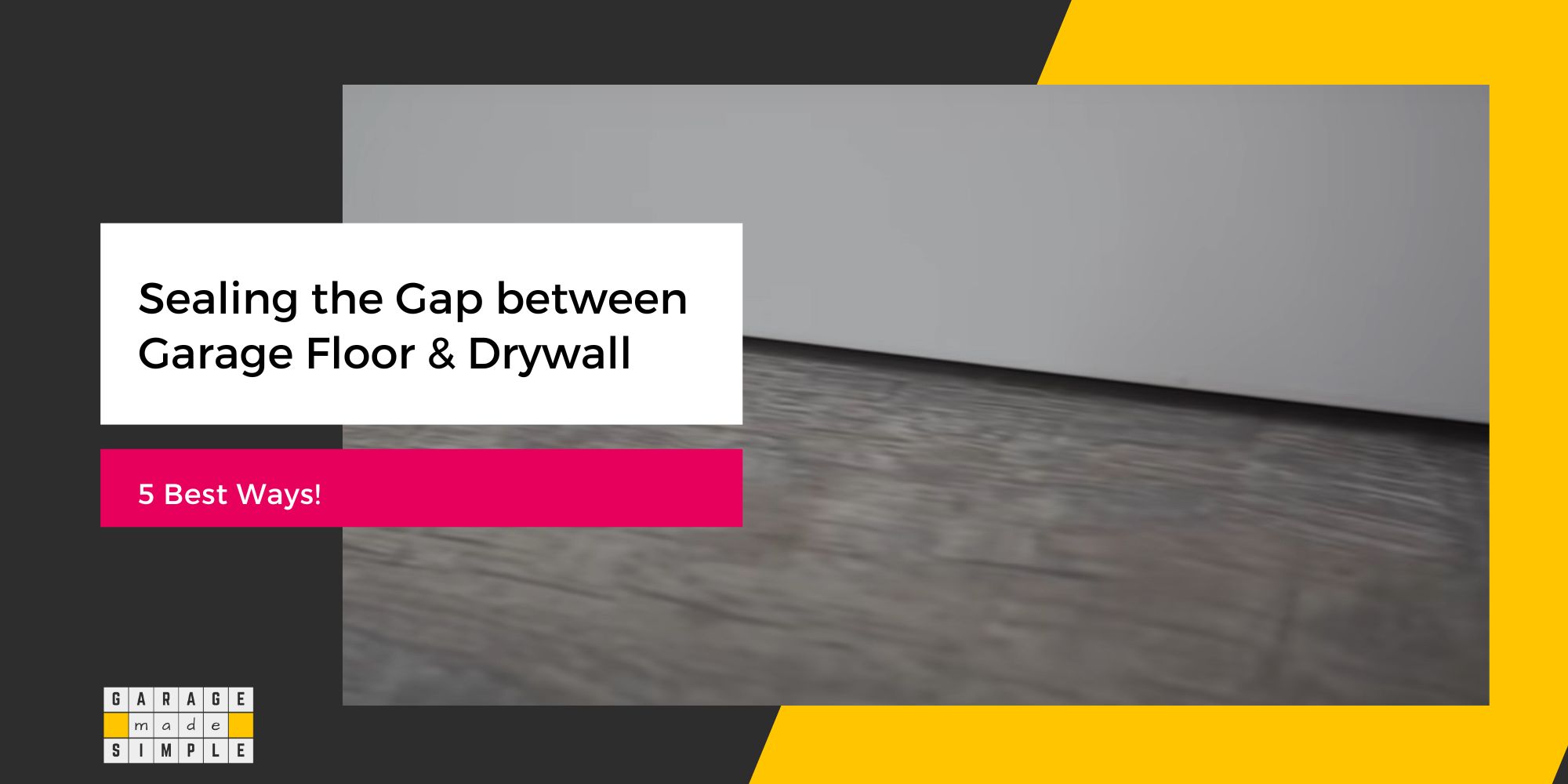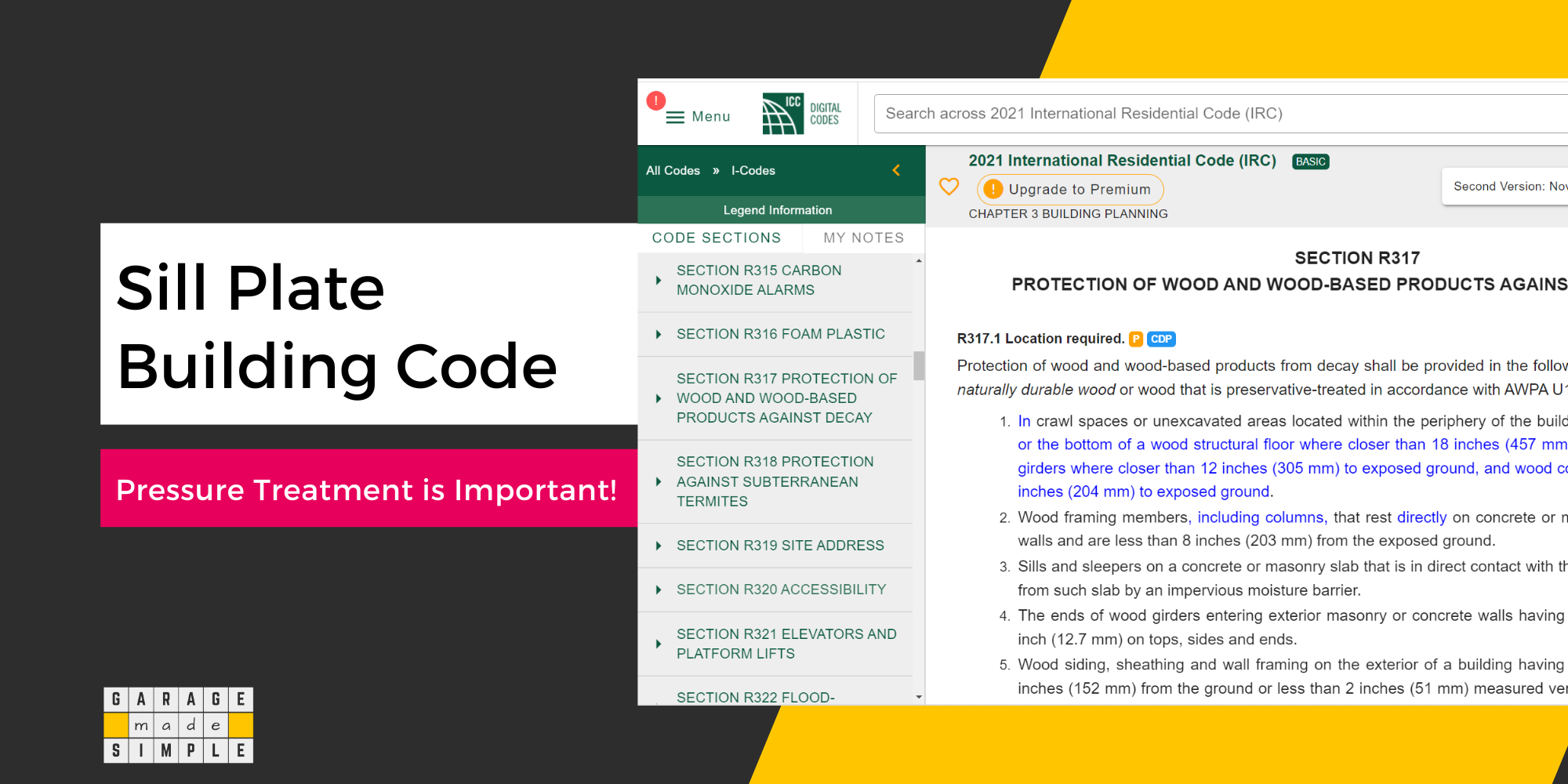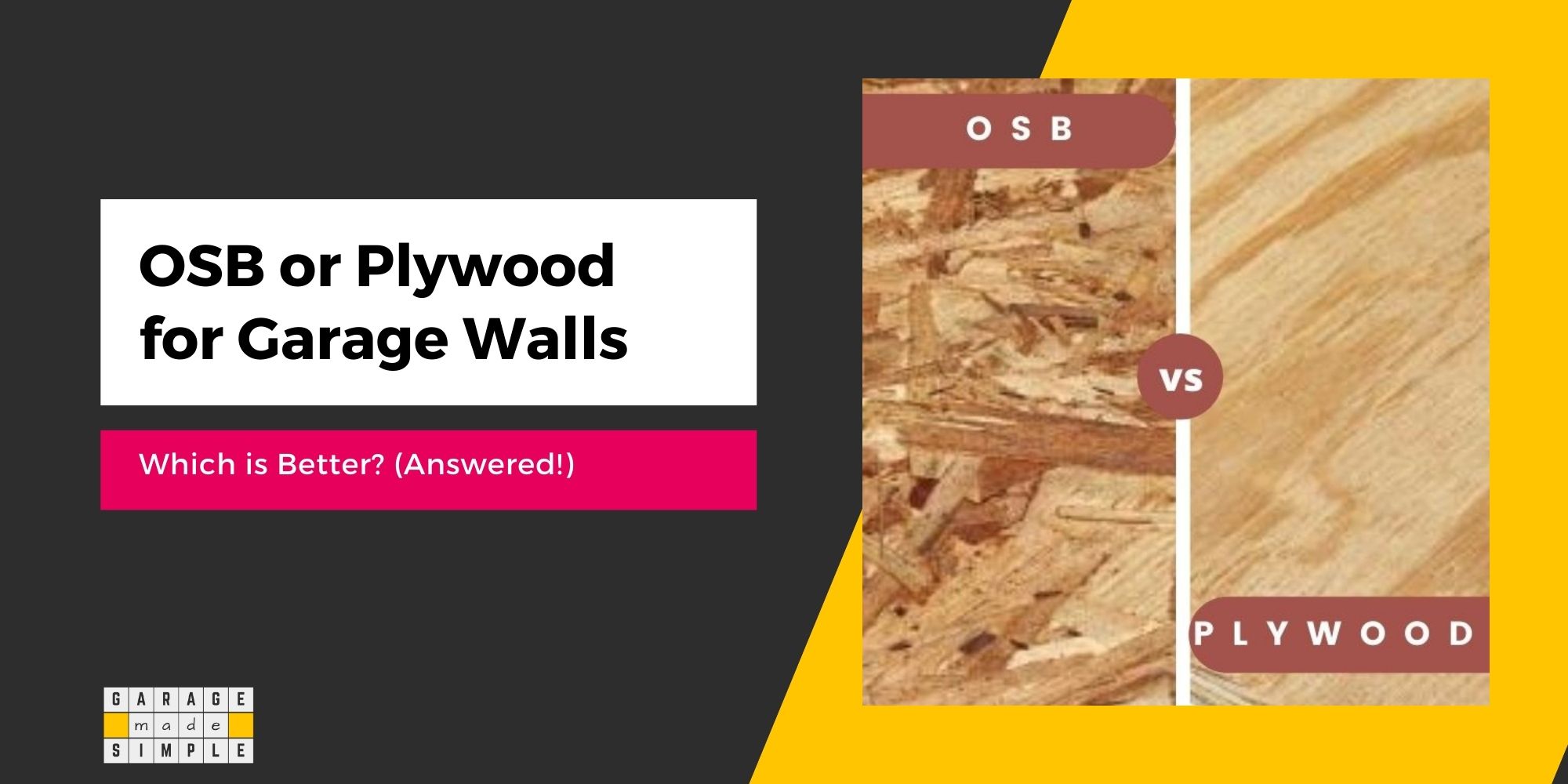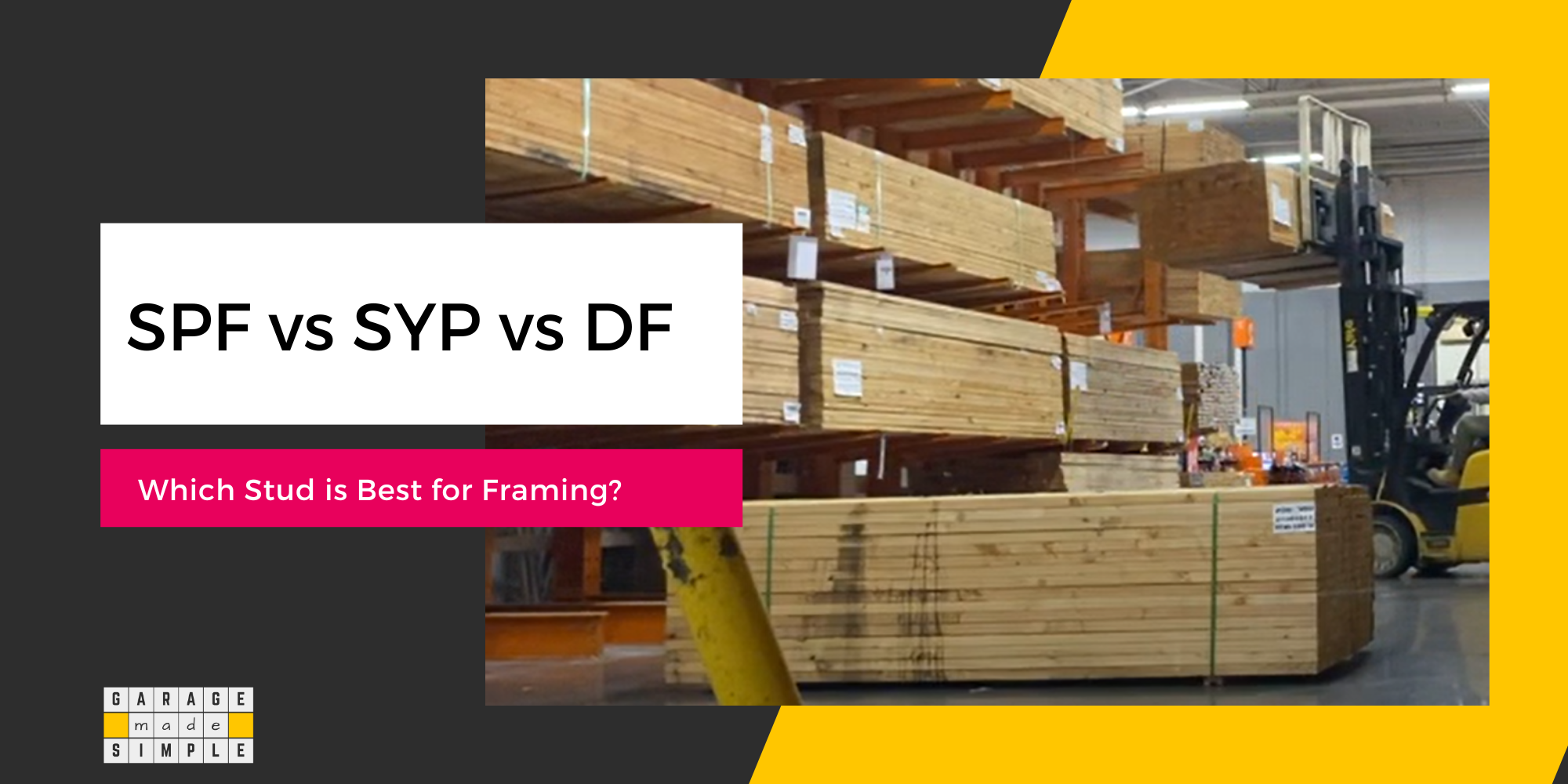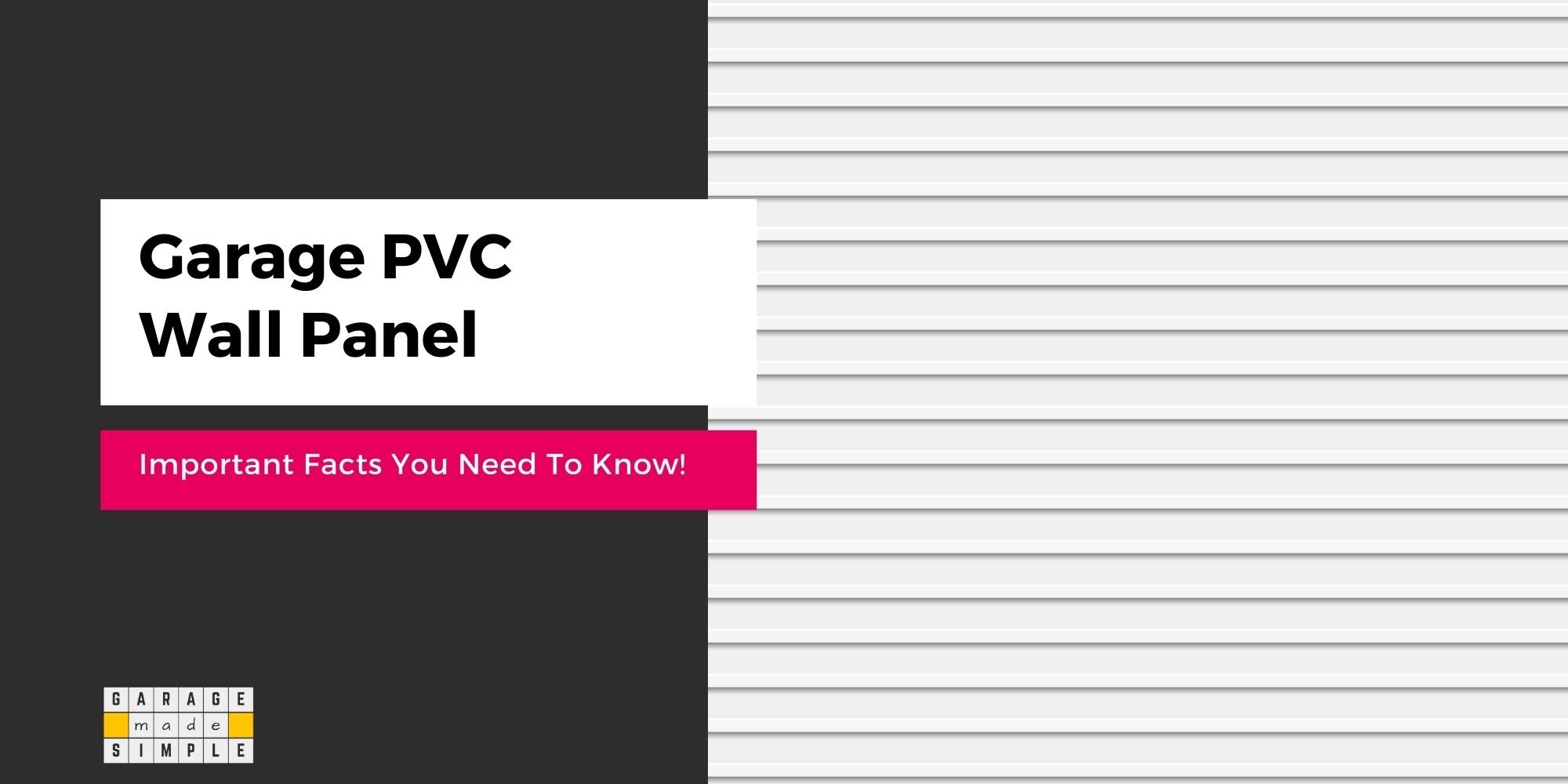Plywood for Garage Walls: The Perfect Solution for Detached Garages
garagemadesimple.com is a participant in the Amazon Services LLC Associates Program, an affiliate advertising program designed to provide a means for sites to earn advertising fees by advertising and linking to Amazon.com . The website is also an affiliate of a few other brands.
Building a detached garage dedicated primarily to a workshop and plenty of storage? Wondering what to use as sheathing? Well, plywood for garage walls is the perfect choice!
Plywood, as a sheathing material, has the required strength, durability, and ease of installation that makes it ideal for use in garages.
So, What is Plywood?
Plywood boards are made from thin layers of wood veneer that are glued together using adhesives. Processing is done under high temperature and pressure for good bonding.

Plywood can be made both from hardwood or softwood. However, plywood made from softwood species, such as pine or spruce, is more popular as softwood is more readily available.
The grain of each layer of veneer runs perpendicular to the grain of the adjacent layers. This cross-grain orientation gives plywood its strength and dimensional stability, making it less likely to warp or crack than solid wood.
Each layer of veneer is known as a ply (hence the name plywood). More plies means thicker and stronger, albeit more expensive plywood.
Plywood is resistant to moisture and insect damage, and it can be treated with fire retardants to increase its fire resistance too. Plywood is also a good insulator, which makes it a popular choice for use in cold climates.
Types & Grades of Plywood
There are four main grades of plywood, each with its own characteristics and applications:
A-grade plywood:
- Characteristics: Smooth, sanded surface, free of knots and defects.
- Applications: High-quality furniture, cabinets, doors, and other interior applications where a smooth, flawless finish is desired.
B-grade plywood:
- Characteristics: Smooth, sanded surface, but may have minor repaired defects, such as football-shaped patches or wood filler. May have tight knots (no chunks of wood missing) up to 1 inch in diameter.
- Applications: General construction, interior paneling, subfloors, and other applications where a smooth finish is not required.
C-grade plywood:
- Characteristics: Visible flaws and knots up to 1.5 inches in diameter. May have splits and discoloration.
- Applications: Rough construction, sheathing, crates, and other applications where appearance is not a major concern.
D-grade plywood:
- Characteristics: Knots and knot holes up to 2.5 inches in diameter. May have splits and generally no repairs.
- Applications: Sheathing, crates, concrete forming, and other applications where appearance and durability are not critical.
In addition to the four main grades, there are also three special grades of plywood:
Exterior-grade plywood:
- Characteristics: Treated to withstand moisture and insect damage.
- Applications: Exterior walls, soffits, and other outdoor applications.
Marine-grade plywood:
- Characteristics: Made with higher quality materials than exterior-grade plywood and is treated to withstand even the harshest weather conditions.
- Applications: Boats, docks, and other marine applications.
Fire-rated plywood:
- Characteristics: Coated with fire resistant chemicals that can withstand open flame for a certain period of time.
- Applications: It is often used in commercial buildings and in areas where there is a high risk of fire.
To know more check out Does Drywall in the Garage Need to Be Fire Rated? (Informative!)
It is important to get the right balance between price and functionality by choosing the appropriate plywood grade for the job at hand.
Advantages of Plywood for Garage Walls
Drywall is often the “go to” choice for garage walls. However, plywood is a great alternative to drywall, especially for detached garages.
Check out Drywall vs Plywood For Garage Walls? (What Is Really Better?) for a comparison.
Some of the key advantages of using plywood for garage walls are:
- Cost-effectiveness: Plywood is a relatively inexpensive option for sheathing interior and exterior garage walls.
- Durability: Plywood is a strong and durable material that is fairly resistant to moisture, insect damage, and impact. Unlike drywall, it will not dent easily or disintegrate under high humidity. You can even hang stuff on it directly.
- Ease of Installation: Plywood is relatively easy to install, even for those with limited DIY experience. It can be cut to size with a circular saw and nailed or screwed to the 2×4 stud garage wall frame.
- Versatility: Plywood can be used for a variety of applications in garage construction. See the section below.
- Aesthetic Appeal: Plywood garage walls give you the option of going for a completely rustic and unfinished look, a chic stained industrial look or a sophisticated painted and finished look.
You can also check out another informative comparison at Drywall vs Plywood For Garage Ceiling? (What Is Really Better?)
Applications of Plywood in Garage Construction
Plywood is a versatile building material that can be used for a variety of applications in garage construction. Its strength, durability, and ease of installation make it a popular choice among homeowners and contractors.
Garage Walls
Plywood for garage walls is certainly the most popular use. You can use plywood as a sheathing for interior garage walls and even as a siding for exterior garage walls,
Of course, you must choose the right grade for each application. Plywood is perfect for detached garages as its use will not violate any code.
Plywood can also be used for walls in an attached garage provided it has the required fire rating or is used on walls that are not adjacent to a dwelling unit (ADU).
Garage Ceiling
Plywood can also be used to install ceilings in garages. It provides a durable and aesthetically pleasing surface that can be painted or stained to match the desired décor.
Plywood ceiling panels are attached to ceiling joists or rafters, providing a smooth and finished appearance to the garage ceiling.
Plywood can also be used to create soffits, which are horizontal sections that conceal the underside of the roof or framing. Plywood soffits provide a clean and finished look to the garage’s interior.
My earlier blog post Use of Plywood for Garage Ceiling: A Comprehensive Guide has a lot of useful information on this subject.
Garage Siding & Roofing
Plywood is often used as siding for exterior walls as well as for roofs in garage construction. Plywood boards can provide the required structural support and weatherproofing
As exterior garage wall siding, plywood covers the framing and provides a layer of protection against wind, rain, and snow. It seals the exterior and prevents moisture from penetrating through the walls.
Plywood also plays a vital role in roof sheathing. It provides a sturdy base for the roofing material and helps to distribute the weight of the roof evenly across the framing system.
Garage Subflooring
Plywood is frequently used as subflooring material in garages. Its strength and durability make it an ideal choice for supporting the weight of vehicles and other heavy objects.
Plywood subfloors are installed over floor joists, providing a solid and level surface for the garage floor. They help distribute the weight evenly and prevent the floor from flexing or sagging.
Plywood’s moisture resistance makes it suitable for garages, where spills and leaks are common. It can withstand moisture without warping or rotting.
Additional Applications
In addition to the above, plywood can also be used in the garage for making:
- Workbenches
- Shelves
- Storage cabinets
- Temporary walls
- Garage doors
- Garage trim
Choosing the Right Plywood for Your Garage Walls
Structural plywood and OSB panels come in a variety of surface textures, enabling you to choose the one that’s right for the intended application. We clarify the differences to help you select the one that’s best for the job. Learn more > https://t.co/cF1jO5Zuei pic.twitter.com/Mpb8Lc7Ogt
— APA – The Engineered Wood Association (@APAwood) November 15, 2023
Selecting the appropriate plywood for garage walls is crucial for ensuring durability, functionality, and aesthetic appeal.
Factors to consider when choosing plywood for garage walls:
- Purpose of the Garage: Not all detached garages are meant to only park cars. If the primary intended use of your detached garage will be for a workshop or storage then consider choosing a thicker and more durable plywood.
- Climate and Weather Conditions: If your garage is located in an area with harsh weather conditions, such as high humidity, coastal environment or extreme temperatures, you may even consider Marine Grade Plywood.
- Moisture Resistance: Garages are often susceptible to moisture due to flooding, roof leaks or ground water wicking. Choose moisture-resistant plywood to prevent warping, rotting, or mold growth. Exterior-grade plywood is a good choice for moisture-prone environments.
- Fire Safety: Fire safety may be less of a concern for detached garages but when it comes to an attached garage I would highly recommend using fire-rated plywood for your garage walls.
Recommendations for different types of garages:
- Storage Garages: For garages primarily used for storage, exterior-grade plywood is a cost-effective and durable option.
- Workshop Garages: If your garage will be used as a workshop, consider using thicker plywood, such as 3/4-inch or 1-inch exterior-grade or marine-grade plywood.
- Attached Garages: Exterior-grade fire-rated plywood is the safest option. It can be painted or stained to match the desired aesthetics.
- Detached Garages: Detached garages may be exposed to more extreme weather conditions, so consider using moisture resistant exterior-grade plywood.
Are Painted Plywood Garage Walls Better? Complete Guide, worth a read.
Proper Handling and Storage
- Before handling plywood, inspect the sheets for any defects, such as cracks, splinters, or damaged edges. Discard any damaged plywood to avoid injury during handling and installation.
- When lifting plywood sheets, use proper lifting techniques to prevent back strain or other injuries. Bend your knees, keep your back straight, and lift with your legs, not your back.
- Store plywood sheets flat on a level surface to prevent warping or damage. Secure the sheets with straps or other means to prevent them from falling or shifting.
- Avoid dragging or sliding plywood sheets across the ground, as this can damage the edges and create tripping hazards. Lift and carry the sheets carefully to avoid accidents.
Use of Personal Protective Equipment
- Wear safety glasses or goggles to protect your eyes from flying debris, sawdust, or splinters when cutting or working with plywood.
- Use a dust mask or respirator to protect your lungs from inhaling sawdust and other airborne particles generated during plywood cutting or sanding.
- Wear work gloves to protect your hands from cuts, splinters, and other injuries when handling plywood. Choose gloves that provide adequate dexterity while ensuring protection.
- Wear earplugs or earmuffs to protect your hearing from loud noises produced by power tools, such as circular saws or sanders, when working with plywood.
Installation of Plywood for Garage Walls
Installation of plywood for garage walls involves a series of steps that ensure a sturdy, durable, and aesthetically pleasing wall structure.
Plywood boards usually come in a standard size of 4’x8’. As detached garages are typically 8’ high and the wall width tends to be a multiple of 4’, it is possible to minimize the cutting of plywood boards by careful planning.
Vertical or Horizontal Sheathing For Garage Walls: Which is Best? is very helpful!
When you do have to cut plywood, mark the plywood sheet with a measuring tape and a pencil, and cut along the marked lines using a circular saw or a handsaw. Sand the edges after cutting.
Carefully lift the cut plywood sheet and align it with the stud wall frame. Start nailing the plywood to the studs, beginning from the bottom and working your way up.
Drive the nails or screws at a consistent spacing, typically 6 inches on center. Once the plywood is fully nailed to the studs, inspect the installation for any gaps or irregularities.
Fill any gaps with caulk or sealant. Lightly sand the surface of the plywood. The desired finish can be obtained by either staining or painting the plywood.
Thank you very much for reading the post. I do hope you found it informative and useful.

